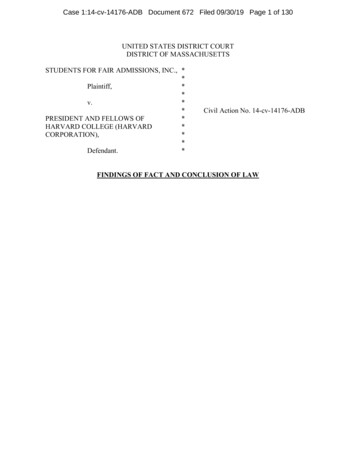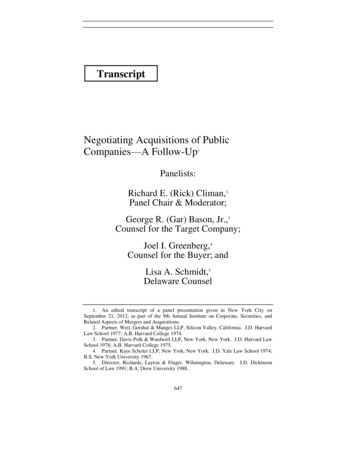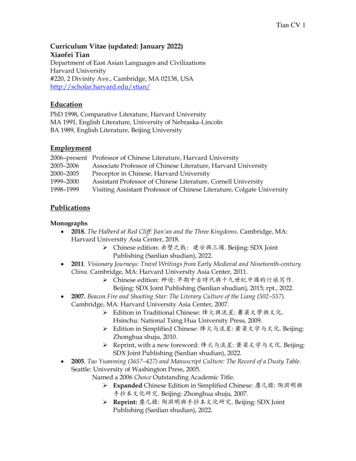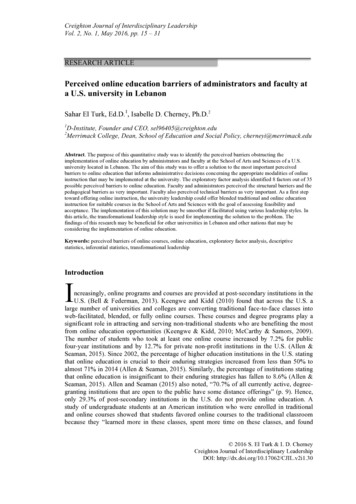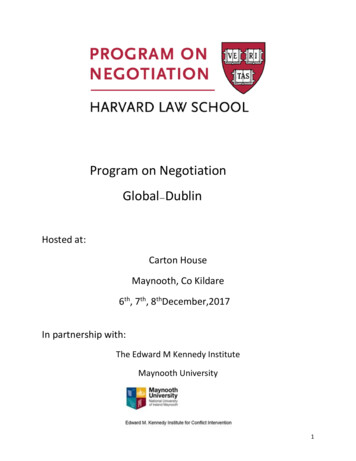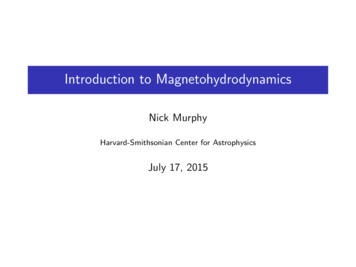
Transcription
Introduction to MagnetohydrodynamicsNick MurphyHarvard-Smithsonian Center for AstrophysicsJuly 17, 2015
To MHD and beyond!IWhat is MHD?IThe equations of MHD and their physical meaningWaves in MHDIIIIIAlfvén wavesSlow magnetosonic wavesFast magnetosonic wavesBeyond MHDIIExtensions to MHDPlasma kinetic theoryIMagnetic reconnectionIFinal thoughts
What is MHD?IMagnetohydrodynamics (MHD) couples Maxwell’s equationsof electromagnetism with hydrodynamics to describe themacroscopic behavior of conducting fluids such as plasmas.
MHD is important in solar physics, astrophysics, spaceplasma physics, and in laboratory plasma experimentsLeft: The International Thermonuclear Experimental Reactor(ITER; currently under construction)Right: Interaction between the solar wind and the Earth’smagnetosphere
MHD at a glance (SI units) ρ tContinuity EquationMomentum EquationAmpere’s lawFaraday’s lawIdeal Ohm’s lawρ t · (ρV) 0 V · V J B pµ0 J B B t EE V B 0 ·B 0Divergence constraintAdiabatic Energy Equationddt pργ 0Definitions: B, magnetic field; V, plasma velocity; J, current density; E, electric field;ρ, mass density; p, plasma pressure; γ, ratio of specific heats (usually 5/3); t, time.
The MHD approximationIAssume the plasma behaves as a fluidIIIAssume that the gyroradius is smallIgnore the most significant physics advances since 1860:IIIILimited applicability to weakly ionized plasmas like thephotosphere and chromosphereAssume collisions are frequent enough that the particledistribution function is MaxwellianIIRelativity (v 2 c 2 )Quantum mechanicsDisplacement current in Ampere’s lawAssume the plasma is fully ionizedIIMacroscopic (low frequency, long wavelength) behaviorNot always true in the solar wind and laboratory plasmasIdeal MHD assumes no resistivity, viscosity, thermalconduction, or radiative cooling
The continuity equation describes conservation of massρVIThe continuity equation written in conservative form is: ρ · (ρV) 0 tIIIThe partial derivative ρ/ t refers to the change in density ata single point in spaceThe divergence of the mass flux · (ρV) says how muchplasma goes in and out of the regionPut sources and sinks of mass on RHS
The second golden rule of astrophysics“The density of wombatstimes the velocity of wombatsgives the flux of wombats.”
The momentum equation is analogous to ma FIThe momentum equation is V · V J B pρ tAdditional forces go on the right hand side (e.g., gravity).IThe total derivative is given by D V· Dt tand represents the derivative you take as you follow a parcelof plasma.IIn a static equilibrium:J B pWhen J B 0, the plasma is ‘force-free’
The pressure gradient force p pushes plasma fromregions of high pressure to low plasma pressure
The Lorentz force term includes two componentsIThe current density is given by the relative drift between ionsand electrons:J ne (Vi Ve ) J B is analogous to F qV B.IUsing vector identities and Ampere’s law (µ0 J B), werewrite the Lorentz force term J B as: 2 B(B · ) B J B µ02µ0However: the Lorentz force is orthogonal to B, but these twoterms are not.
The Lorentz force can be decomposed into two terms withforces othogonal to B using field line curvatureIThe curvature vector κ points toward the center of curvatureand gives the rate at which the tangent vector turns:IWe can then write the Lorentz force as 2 BB2J κ (1) {z B}µ02µ0 {z} {z}Lorentz forcemagnetic tension magnetic pressurewhere all terms are orthogonal to B. The operator takesthe gradient only in the direction orthogonal to B.
The magnetic tension force wants to straighten magneticfield linesIThe tension force is directed radially inward with respect tomagnetic field line curvature
Regions of high magnetic pressure exert a force towardsregions of low magnetic pressureIThe magnetic pressure is given by pB B22µ0
The ratio of the plasma pressure to the magnetic pressureis an important dimensionless numberIDefine plasma β asβ IIf β 1 then the magnetic field dominatesIISolar coronaIf β 1 then plasma pressure forces dominateIIplasma pressurep 2magnetic pressureB /2µ0Solar interiorIf β 1 then pressure/magnetic forces are both importantIIISolar chromosphereParts of the solar wind and interstellar mediumSome laboratory plasma experiments
Faraday’s law tells us how the magnetic field varies withtime B E tBut how do we get the electric field?
Ohm’s law provides the electric fieldIThe ideal MHD Ohm’s law is given byE V B 0IIn ideal MHD, the magnetic field is frozen-in to the plasma. Iftwo parcels of plasma are connected by a magnetic field lineat one time, then they will be connected by a magnetic fieldline at all other times.IFor resistive MHD, Ohm’s law becomesE V B ηJwhere η is the resistivity. Resistivity allows the frozen-incondition to be broken.ICan also include the Hall effect which is important on shortlength scales
With Ohm’s law we can rewrite Faraday’s law as theinduction equationIUsing the resistive Ohm’s law: Bη 2 (V B) B {z} µ0 t {z }convectiondiffusionDiffusion is usually represented by a second order spatialderivative.IAn example of resistive diffusion:
Thermal conductionIThermal conduction is a common extension to MHDIHeat diffuses much more quickly along magnetic field linesthan orthogonal to themIAnisotropic thermal conduction is a challenge in numericalsimulationsThe temperature along magnetic field lines is usuallyapproximately constantIIExceptions: when localized heating occurs on short timescales,or there are rapid connectivity changes
WavesIThere are three primary waves that arise from MHD:IIIIAlfvén waveSlow magnetosonic waveFast magnetosonic waveThere are two important speedsIThe sound speed is given byrCs IγpρThe Alfvén speed is given byBVA µ0 ρ
Alfvén WavesI Alfvén waves propagate at the Alfvén speed, VA B/ µ0 ρIThe restoring force is magnetic tensionIThis is a shear wave with no compression involvedIDisturbances propagate parallel to B
Slow and Fast Magnetosonic WavesILeft: The restoring forces for magnetosonic waves propagatingperpendicular to B are given by gas and magnetic pressuregradients. This shows a compressional wave.IRight: The phase velocity of MHD waves as a function ofangle when B is in the z direction and β is small.ISound waves are magnetosonic waves propagating along B
How useful is MHD?IIMHD is appropriate for large-scale, low-frequency behaviorMHD is a good predictor of stabilityIINon-MHD effects sometimes stabilize or destabilize. . .MHD is often inappropriate when there are non-Maxwelliandistribution functionsIIncluding in collisionless plasmas or when there are energetic,non-thermal particlesIMHD is a reasonable approximation for most solar physicsapplications, but there are many effects beyond MHD that willoften be importantIMHD usually does not usually work well for laboratory plasmas
There are two general approaches to going beyond MHDIExtended MHD. Keep the fluid approximation but includeeffects such asIIIIIIKinetic theory. Abandon the fluid approximation and keeptrack of particle distribution function.IIAnisotropic thermal conductionDifferent ion and electron temperatures: Tion 6 TelectronDifferent pressures parallel and perpendicular to B: p 6 pkFinite Larmor radius effectsHall effectComputationally intensive but often necessary to includeimportant physical processesSometimes we can take a hybrid between these twoapproaches
Magnetic Reconnection is the breaking and rejoining ofmagnetic field lines in a highly conducting plasma
Solar flares and CMEs are powered by magneticreconnectionIExplosive release of magnetic energyIBidirectional Alfvénic jetsIVery efficient particle accelerationIFlux ropes escape as coronal mass ejections (CMEs)
Magnetic reconnection is a fundamental process inlaboratory and astrophysical plasmasIClassical theories based on resistive diffusion predict slowreconnection (weeks to months. . . )IFast reconnection allows magnetic energy to be explosivelyconverted into kinetic and thermal energyICollisionless or non-fluid effects are (probably) needed toexplain why fast reconnection occurs in flares (tens of secondsto minutes!)
SummaryIMHD describes the macroscopic behavior of plasmasIEach term in the MHD equations represents a differentphysical effectIThere are three types of MHD waves: Alfvén waves, fastmagnetosonic waves, and slow magnetosonic wavesIOften, physics beyond MHD is needed to describe plasmaphysics phenomenaMagnetic reconnection is the breaking and rejoining ofmagnetic field lines in a highly conducting plasmaIIIReleases magnetic energy during solar flares and CMEsDegrades confinement in laboratory plasmas
Useful referencesIThe Physics of Plasmas by T.J.M. Boyd and J.J. Sanderson.One of the most understandable introductions to plasmaphysics that I’ve found.IMagnetohydrodynamics of the Sun by Eric Priest. Very usefulresource for the mathematical properties of MHD as appliedto the Sun.IPrinciples of Magnetohydrodynamics by Hans Goedbloed andStefaan Poedts. Good introduction to MHD with a broadfocus on applications.IIdeal Magnetohydrodynamics by Jeffrey Freidberg. Very goodout-of-print introduction to MHD in particular. Later chaptersfocus more on laboratory plasmas.IIntroduction to Plasma Physics and Controlled Fusion byFrancis Chen. A beginning graduate level introduction toplasma physics. Less emphasis on MHD.
The MHD approximation I Assume the plasma behaves as a uid I Macroscopic (low frequency, long wavelength) behavior I Assume that the gyroradius is small I Ignore the most signi cant physics advances since 1860: I Relativity (v 2 c ) I Quantum mechanics I Displacement current in Ampere's law I Assume the plasma is fully ionized I Limited applicability to weakly ionized plasmas like the





